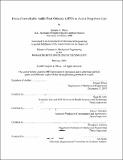| dc.contributor.advisor | Hugh M. Herr, Dava J. Newman and Woodie C. Flowers. | en_US |
| dc.contributor.author | Blaya, Joaquin A. (Joaquin Andres), 1978- | en_US |
| dc.contributor.other | Massachusetts Institute of Technology. Dept. of Mechanical Engineering. | en_US |
| dc.date.accessioned | 2005-09-26T19:33:36Z | |
| dc.date.available | 2005-09-26T19:33:36Z | |
| dc.date.copyright | 2002 | en_US |
| dc.date.issued | 2003 | en_US |
| dc.identifier.uri | http://hdl.handle.net/1721.1/28282 | |
| dc.description | Thesis (S.M.)--Massachusetts Institute of Technology, Dept. of Mechanical Engineering, February 2003. | en_US |
| dc.description | Includes bibliographical references (leaves 81-85). | en_US |
| dc.description.abstract | Drop foot, a loss of use of the muscles that lift the foot, can be caused by stroke, cerebral palsy (CP), multiple sclerosis (MS), or neurological trauma. The two major complications of drop foot are slapping of the foot after heel strike (foot slap) and dragging of the toe during swing (toe drag). The current assistive device is the Ankle Foot Orthosis (AFO), which though offering some biomechanical benefits, is nonadaptive and fails to eliminate significant gait complications. An Active Ankle Foot Orthosis (AAFO) is presented where the impedance of the orthotic joint is modulated throughout the walking cycle to treat drop foot gait. To prevent foot slap, a biomimetic torsional spring control is applied where orthotic joint stiffness is actively adjusted to minimize forefoot collisions with the ground. Throughout late stance, joint impedance is minimized so as not to impede powered plantar flexion movements, and during the swing phase, a torsional spring-damper (PD) control lifts the foot to provide toe clearance. To assess the clinical effects of variable-impedance control, kinetic and kinematic gait data were collected on two drop foot participants wearing the AAFO. For each participant, zero, constant and variable impedance control strategies were evaluated, and the results were compared to the mechanics of three age, weight and height matched normals. It was found that actively adjusting joint impedance significantly reduces the occurrence of slap foot, allows greater powered plantar flexion, and provides for greater biological realism in swing phase ankle dynamics. These results indicate that a variable-impedance orthosis may have certain clinical benefits for the treatment of drop foot gait compared to conventional AFO having zero or constant stiffness joint behaviors. | en_US |
| dc.description.statementofresponsibility | by Joaquin A. Blaya. | en_US |
| dc.format.extent | 96 leaves | en_US |
| dc.format.extent | 5759740 bytes | |
| dc.format.extent | 5770903 bytes | |
| dc.format.mimetype | application/pdf | |
| dc.format.mimetype | application/pdf | |
| dc.language.iso | en_US | |
| dc.publisher | Massachusetts Institute of Technology | en_US |
| dc.rights | M.I.T. theses are protected by copyright. They may be viewed from this source for any purpose, but reproduction or distribution in any format is prohibited without written permission. See provided URL for inquiries about permission. | en_US |
| dc.rights.uri | http://dspace.mit.edu/handle/1721.1/7582 | |
| dc.subject | Mechanical Engineering. | en_US |
| dc.title | Force-controllable ankle foot orthosis (AFO) to assist drop foot gait | en_US |
| dc.title.alternative | Force-controllable AFO to assist drop foot gait | en_US |
| dc.type | Thesis | en_US |
| dc.description.degree | S.M. | en_US |
| dc.contributor.department | Massachusetts Institute of Technology. Department of Mechanical Engineering | |
| dc.identifier.oclc | 53324241 | en_US |
